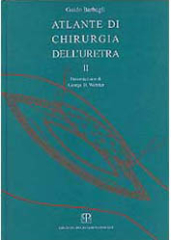Editor: Edizioni Polistampa, Florence
Guido Barbagli
Language Italian.
The book is available. Please contact the Editor: Edizioni Polistampa
The book includes three different chapters: surgical techniques for strictures of navicularis urethra, penile urethra and bulbar urethra. Ten different surgical techniques (one-stage or two-stage) for anterior urethral strictures repair are described step-by-step using black and white illustrations and color intraoperative pictures.
Foreword by George D. Webster:
The surgical repair of urethral stricture continues to evolve. Historically, staged repairs were performed for most strictures; however, today, such procedures are reserved fro complex situations. The emphasis now is on single repairs and an array of procedures is available. The successful management of urethral strictures demands attention not only to surgical details but to procedure selection. No single technique is appropriate fro all situations and the successful surgeon will have a repertoire of operations to choose from. Stricture location, length, complicating features, multiplicity and proximity to or involvement of the sphincter mechanism all have impact on the choice of appropriate operation. While the surgeon’s goal is to create a urethral lumen of even caliber, this must not be accomplished at the expense of continence and sexual dysfunction. Certainly sexual function can be placed at risk by any surgery on the genitalia and dissection must avoid interference with neurovascular supply to the penis and the use of flaps and grafts should not compromise penile length, should not cause penile chordee and certainly should not untowardly affect penile appearance. It is with all of these factors in mind that Dr. Barbagli has prepared this Atlas illustrating his approach to the surgical repair of stricture of the anterior urethra. The clarity of illustrations is remarkable, the very schematic technique rendering each illustration uncluttered and easy to interpret. The color plates are exquisite and complement the illustrations and text tastefully. Dr. Barbagli approach leans heavily on the dorsal onlay graft repair which is certainly an optimal approach fro bulbar strictures to long for anastomotic repair. This technique has major advantages over the historic full thickness graft onlay procedures in which the urethral lumen was approached from the ventral surface. His technique enhances graft take by spread fixing the graft to a secure graft bed (the undersurface of the corporal body) which has excellent blood supply, and the spread fixation reduces the risk of graft shrinkage, and the graft bed avoids the problem of sacculation. Recognizing the role of flap repair for pendulous urethral strictures the text and illustrations depict the classic inlay island flap for reconstruction of penile urethral and glandular urethral strictures., as an alternative. The repair of urethral stricture will continue to improve and the next evolution is likely to be with respect to substitution materials. The dorsal onlay technique described by Dr. Barbagli lends its self to the use of graft other than full thickness skin. Fenestrated full thickness penile skin is always the first choice, but is not always abundantly available. Buccal mucosa proves to be an excellent alternative using this technique and in the future, in vitro cultured epithelial sheets are likely to be available. It is opened that this Atlas will take the surgical repair of urethral stricture from the hands of the expert to those of well trained urologist, because of simplicity and adaptability of the techniques described. However, it must constantly be recognized that urethroplasty surgery is somewhat unforgiving and simple situations can be compounded into major reconstructive problems by inexpert repair. The adage that “the first opportunity is always the best” being very true in urethral surgery. It should also be recognized that success in urethroplasty surgery is not measured in one or even in five years outcomes and we are constantly reminded by late failures that there is no true substitute for normal urethra!
George D. Webster, Duke University Medical Center, Durham, North Carolina, USA

